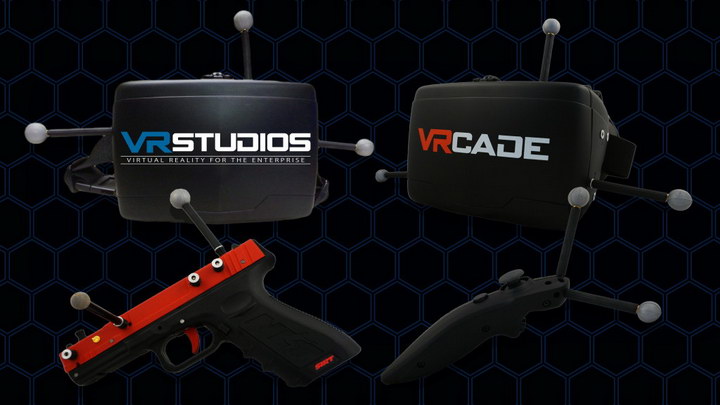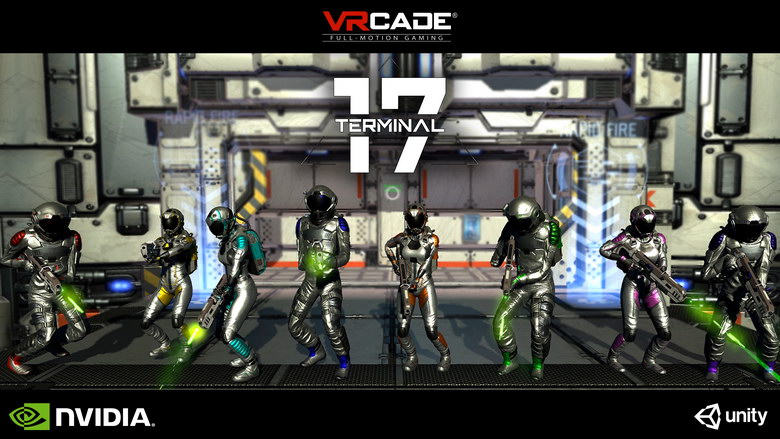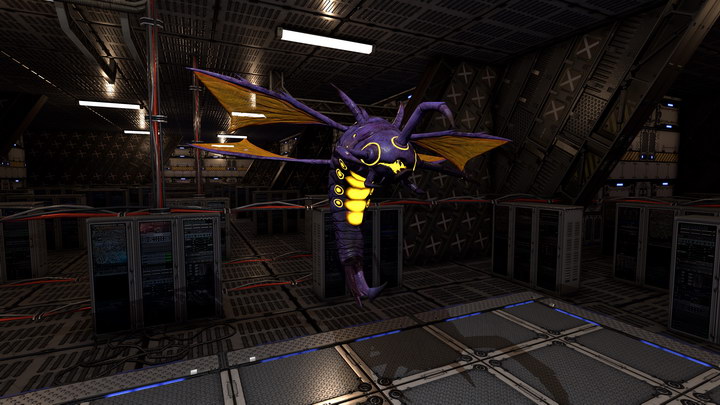VRstudios provides six degree-of-freedom (6DOF) virtual reality (VR) systems for out-of-home entertainment centers such as theme parks. 6DOF VR systems allow the person wearing the VR head mounted display (HMD) to not only look in any direction but to roam freely within a defined area.

This compares to home VR systems and, for that matter, most commercial VR entertainment centers such as the VR systems showing up in movie theaters which only offer three degree-of-freedom (3DOF) systems. In a 3DOF system the user can look in any direction but is not allowed to roam. Any motion of the viewpoint center is controlled by the content creator, not the end user. 360° video is an example of a 3DOF system.
![]() VRstudios started informally in 2012 when a small group of technologists began work on the company’s original concept – creating a totally wireless VR system with full-motion tracking technology. The initial target was to allow full motion across open spaces up to 30’ x 30’ (9.1m x 9.1m). This initial technology was proven by late 2013 and the company was officially founded in July of 2014. In the 2015-2017 time frame, VRstudios is said to have become the largest provider of commercial, location-based entertainment (LBE) VR attractions in the world. The company has sold and installed 53 systems in 14 countries to date. Its offices are in Bellevue, Washington plus it has a 6500 square foot (604m²) warehouse nearby for developing, setting up and demonstrating its systems.
VRstudios started informally in 2012 when a small group of technologists began work on the company’s original concept – creating a totally wireless VR system with full-motion tracking technology. The initial target was to allow full motion across open spaces up to 30’ x 30’ (9.1m x 9.1m). This initial technology was proven by late 2013 and the company was officially founded in July of 2014. In the 2015-2017 time frame, VRstudios is said to have become the largest provider of commercial, location-based entertainment (LBE) VR attractions in the world. The company has sold and installed 53 systems in 14 countries to date. Its offices are in Bellevue, Washington plus it has a 6500 square foot (604m²) warehouse nearby for developing, setting up and demonstrating its systems.
 HMDs and accessories from VRstudios for their VRcade systems. The round balls mounted on the systems are for optical tracking by OoptiTrack cameras. (Credit: VRstudios)
HMDs and accessories from VRstudios for their VRcade systems. The round balls mounted on the systems are for optical tracking by OoptiTrack cameras. (Credit: VRstudios)
I had a chance to talk to T. Ron Davis, Chief Marketing Officer of VRstudios, about the company and its products. Currently, its two main products are VRcade Zone and VRcade Arena plus the just announced VRcade PowerPlay.
VRcade Zone allows two people to wander freely about an area of 15’ x 15’ (4.6m x 4.6m) or 30’ x 30’ (9.1m x 9.1m). The participants both wear HMDs designed by VRstudios that have 640 x 800 resolution per eye and show 3D images. Davis told me they had to design their own HMDs because they wanted units that were fully wireless. The systems talk to the host computer, a high-end gaming laptop, via a WiGig link in the 60GHz band. The VRcade Zone participants do not need to wear a backpack computer to produce the images – they come from the host.
The images they see are of a virtual space created by 3D modeling and they can move around freely in that space. Besides the virtual space, each can see the other participant in that space so when they move around, there are (or should be) no collisions between the two participants. Davis told me there is essentially no lag time: when the participants move, the image changes to match that move. This makes it possible to walk and move around freely in the space. Davis also told me that with all the system demonstrations he has supervised, there has never been a case of VR sickness. He attributes this, probably correctly, to the fact that there is a good match between what the eyes see and what the body, including the inner ears, senses.
VRstudios has created five branded titles for the VRcade Zone, as well as two custom titles for two major theme parks. Typically these experiences are three to five minutes. The VRcade Zone turnkey solution consists of the VRcade Zone system hardware and software, the Attraction Management Platform (AMP) software, content, installation, training and support. Davis told me that the VRcade Zone system can be run by a single employee but it generally works better and more smoothly with two.
Seven participants working as a team in a VRcade Arena system at the IAAPA Attractions Expo in Orlando last November. (Credit: VRstudios)
VRstudios announced their VRcade Arena system in July 2017. This system is designed for a 40’ x 60’ (12.2m x 18.3m) space. Instead of just two participants, it can accommodate up to eight participants. In this system, the participants wear Oculus HMDs showing 3D images with 1080 x 1200 resolution. Each HMD is tethered to a backpack computer worn by each participant. The backpack computer communicates with the host computer, a high-powered desktop, via the 5GHz band.
While this is one of the frequency bands used by Wi-Fi, Davis said that interference with Wi-Fi has not been a major problem. For example, he told me, at last November’s International Association of Amusement Parks and Attractions (IAAPA) Attractions Expo in the Orange County Convention Center in Orlando (Where else?), they used the 5GHz band without a problem, once it was set up. He said they did have to choose the channels in the 5GHz RF band to avoid interference. He said he’s never seen an example of interference at an LBE demo site.
For IAAPA, VRstudios showed VRcade Arena in a 20’ x 60’ (6.1m x 18.3m) custom configuration instead of its standard 40’ x 60’ arena. Davis said they did this half-sized arena due to space limitations at the IAAPA Expo. He says the company does not like to do custom sizes because it requires re-doing the 3D model of the virtual space the participants are playing in. The company was willing to do this for the IAAPA because of the importance of the Expo to their business. Presumably, they would also customize it as desired for paying customers. For example, he said, while VRcade Zone is normally either 15’ x 15’ or 30’ x 30’, they have also done some installations of 20’x 20’ (6.1m x 6.1m) systems.
Davis told me that the 500 available demo slot reservations were all taken before the IAAPA Expo even opened. The company was giving demos from 8:00, before the show floor opened, till 7:00 in the evening, after it was officially closed, for all four days of the Expo. In the end, a lot more people than 500 got to try the system. He added that VRstudios set up 10 large displays (about 50″) around their booth so other Expo visitors could see what was going on. The displays could not only show any player’s eye view, but show the game from the point of view of “Player Zero” with a bird’s-eye view of the entire virtual playing area. He said they were considering renting a large videowall for this year’s IAAPA Expo.
 Terminal 17 is a game for the VRcade Arena system. (Credit: VRstudios)
Terminal 17 is a game for the VRcade Arena system. (Credit: VRstudios)
Terminal 17 is the current attraction for the VRcade Arena system and was shown at the IAAPA Expo. It comes in two versions, 15 minutes and 30 minutes. It is said to be an intense, multiplayer adventure game. Players are part of an eight-person extermination squad tasked with finding and eliminating alien insects that are wreaking havoc on Terminal 17, a remote facility on a distant planet. Participants journey through a massive virtual world by walking physically around the VRcade Arena and by using a variety of virtual transportation methods.
 Alien insect in Terminal 17 (Credit: VRstudios)
Alien insect in Terminal 17 (Credit: VRstudios)
All participants in Terminal 17 can see the other participants. Or rather, they can see the other participants’ avatars, which are wearing spacesuits. They communicate with other players using high-quality, positional voice chat to cooperatively solve puzzles and advance through multiple floors of Terminal 17, ridding the facility of the deep infestation. According to Davis, the voices from other players not only come from the correct direction but also with the correct loudness to indicate just where they are. Turn your head to look at them and the sound changes to also come from the correct direction.
 Red and Blue teams wait for the start signal in PowerPlay (Credit: VRstudio)
Red and Blue teams wait for the start signal in PowerPlay (Credit: VRstudio)
What originally attracted my attention to VRstudios was the announcement on March 7th of VRcade PowerPlay, the company’s newest product. The hardware used by PowerPlay is the same as the VRcade Arena hardware. Again, the images seen by the players are 3D and the audio is positional.
The system is targeted at the e-sports market. In normal e-sports, teams of players compete against one another in more-or-less conventional videogames. Even so, e-sports draw huge audiences, Davis told me. For example, the recent DOTA 2017 Championships in the Key Arena in Seattle drew 14,000 in-person attendees (at $100 – $200 apiece!) and 400K viewers on-line. The prize pool for the participating teams was $34M.
PowerPlay, like Terminal 17, is a 6DOF full motion system. In Terminal 17 all players are on the same side, fighting the alien insects. In PowerPlay, the participants are divided into two teams of four and the teams compete against each other. Davis sees this as the next step for e-sports, since players not only have the need for good gaming skills but athleticism as well.
Chanel Summers, VRstudios’ Vice President of Creative Development said about PowerPlay, “It combines a retro game aesthetic with a futuristic battlefield setting to showcase a truly physical sport in a nearly unlimited virtual arena. By design, the eAthletes quickly forget that they are in a virtual experience and move naturally in all the same ways that they would on a real-world playing field, including running, ducking, and jumping to beat the competition. The physical action, range of motion and dynamic competitive match formats definitely qualify VRcade PowerPlay as the sport of the future.” –Matthew Brennesholtz
(Editor’s note. Article corrected as wrong headsets were listed in the PowerPlay).

